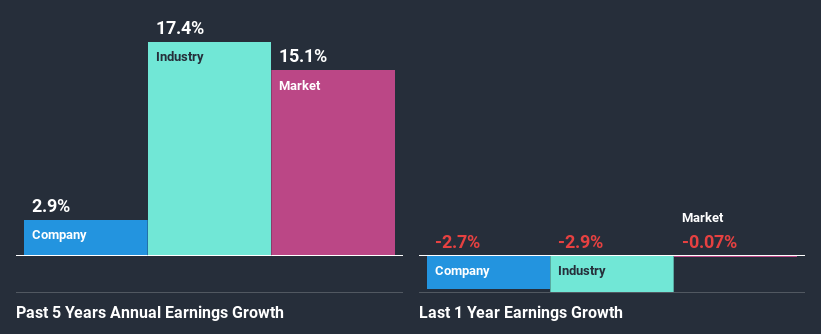- India
- /
- Construction
- /
- NSEI:CORALFINAC
Coral India Finance and Housing Limited's (NSE:CORALFINAC) Stock is Soaring But Financials Seem Inconsistent: Will The Uptrend Continue?

Coral India Finance and Housing (NSE:CORALFINAC) has had a great run on the share market with its stock up by a significant 73% over the last three months. But the company's key financial indicators appear to be differing across the board and that makes us question whether or not the company's current share price momentum can be maintained. Particularly, we will be paying attention to Coral India Finance and Housing's ROE today.
Return on equity or ROE is an important factor to be considered by a shareholder because it tells them how effectively their capital is being reinvested. In short, ROE shows the profit each dollar generates with respect to its shareholder investments.
See our latest analysis for Coral India Finance and Housing
How Is ROE Calculated?
The formula for ROE is:
Return on Equity = Net Profit (from continuing operations) ÷ Shareholders' Equity
So, based on the above formula, the ROE for Coral India Finance and Housing is:
6.8% = ₹80m ÷ ₹1.2b (Based on the trailing twelve months to March 2020).
The 'return' refers to a company's earnings over the last year. One way to conceptualize this is that for each ₹1 of shareholders' capital it has, the company made ₹0.07 in profit.
What Has ROE Got To Do With Earnings Growth?
So far, we've learned that ROE is a measure of a company's profitability. We now need to evaluate how much profit the company reinvests or "retains" for future growth which then gives us an idea about the growth potential of the company. Assuming all else is equal, companies that have both a higher return on equity and higher profit retention are usually the ones that have a higher growth rate when compared to companies that don't have the same features.
A Side By Side comparison of Coral India Finance and Housing's Earnings Growth And 6.8% ROE
It is quite clear that Coral India Finance and Housing's ROE is rather low. Even when compared to the industry average of 9.5%, the ROE figure is pretty disappointing. Therefore, the disappointing ROE therefore provides a background to Coral India Finance and Housing's very little net income growth of 2.9% over the past five years.
As a next step, we compared Coral India Finance and Housing's net income growth with the industry and were disappointed to see that the company's growth is lower than the industry average growth of 17% in the same period.

Earnings growth is a huge factor in stock valuation. The investor should try to establish if the expected growth or decline in earnings, whichever the case may be, is priced in. By doing so, they will have an idea if the stock is headed into clear blue waters or if swampy waters await. One good indicator of expected earnings growth is the P/E ratio which determines the price the market is willing to pay for a stock based on its earnings prospects. So, you may want to check if Coral India Finance and Housing is trading on a high P/E or a low P/E, relative to its industry.
Is Coral India Finance and Housing Making Efficient Use Of Its Profits?
A low three-year median payout ratio of 12% (implying that the company retains the remaining 88% of its income) suggests that Coral India Finance and Housing is retaining most of its profits. However, the low earnings growth number doesn't reflect this as high growth usually follows high profit retention. So there might be other factors at play here which could potentially be hampering growth. For example, the business has faced some headwinds.
In addition, Coral India Finance and Housing has been paying dividends over a period of six years suggesting that keeping up dividend payments is way more important to the management even if it comes at the cost of business growth.
Conclusion
Overall, we have mixed feelings about Coral India Finance and Housing. Even though it appears to be retaining most of its profits, given the low ROE, investors may not be benefitting from all that reinvestment after all. The low earnings growth suggests our theory correct. Wrapping up, we would proceed with caution with this company and one way of doing that would be to look at the risk profile of the business. Our risks dashboard would have the 4 risks we have identified for Coral India Finance and Housing.
When trading Coral India Finance and Housing or any other investment, use the platform considered by many to be the Professional's Gateway to the Worlds Market, Interactive Brokers. You get the lowest-cost* trading on stocks, options, futures, forex, bonds and funds worldwide from a single integrated account. Promoted
New: AI Stock Screener & Alerts
Our new AI Stock Screener scans the market every day to uncover opportunities.
• Dividend Powerhouses (3%+ Yield)
• Undervalued Small Caps with Insider Buying
• High growth Tech and AI Companies
Or build your own from over 50 metrics.
This article by Simply Wall St is general in nature. It does not constitute a recommendation to buy or sell any stock, and does not take account of your objectives, or your financial situation. We aim to bring you long-term focused analysis driven by fundamental data. Note that our analysis may not factor in the latest price-sensitive company announcements or qualitative material. Simply Wall St has no position in any stocks mentioned.
*Interactive Brokers Rated Lowest Cost Broker by StockBrokers.com Annual Online Review 2020
Have feedback on this article? Concerned about the content? Get in touch with us directly. Alternatively, email editorial-team@simplywallst.com.
About NSEI:CORALFINAC
Coral India Finance and Housing
Provides investment services in the in India.
Flawless balance sheet average dividend payer.
Market Insights
Community Narratives



